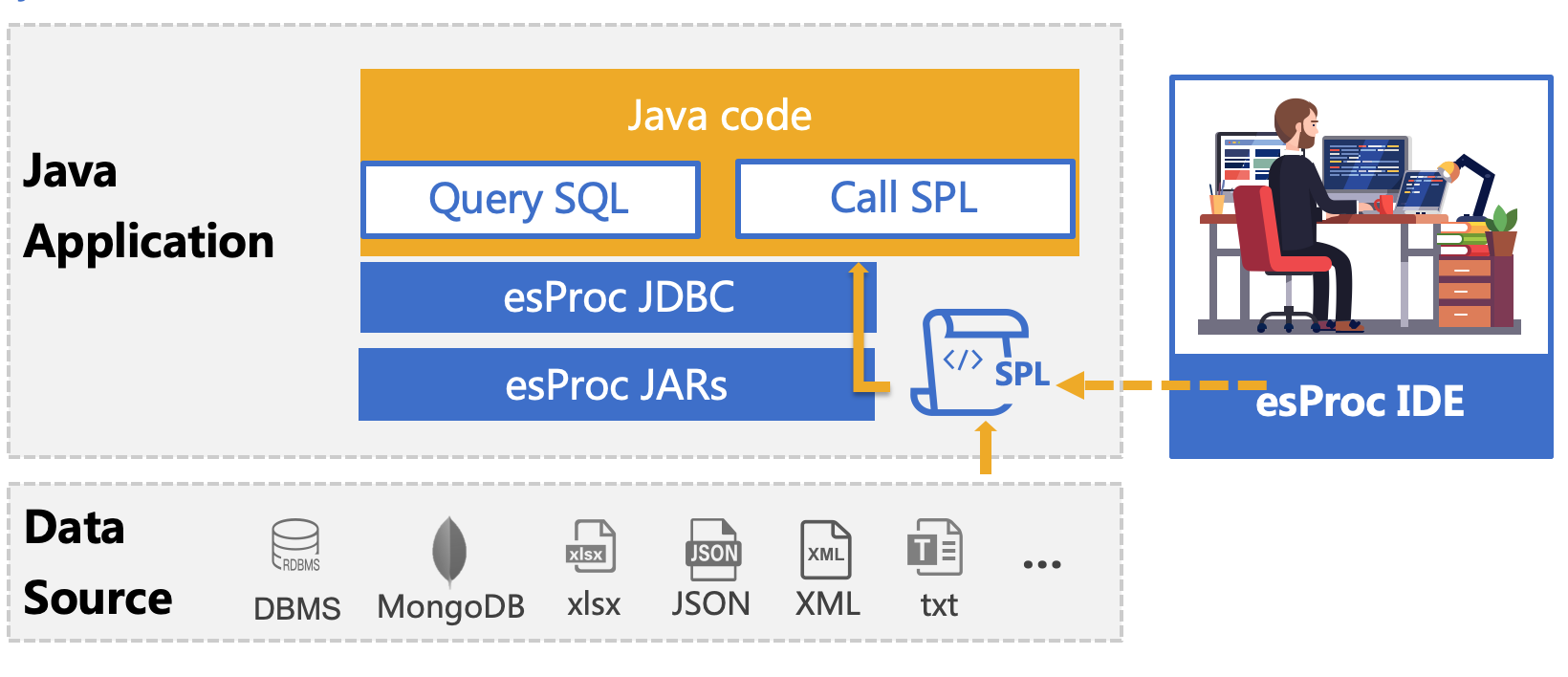What would be a dynamic and flexible way to transform Json to Java object?
To other questions:
How to easily handle text file calculations in Java?
How to easily consolidate data from different sources in Java?
What should a Java programmer do when it is too difficult to write complex SQL?
What is the lightweight Java library to read and write Excel dynamically?
How to perform SQL-like queries on MongoDB in Java?
What should I do when it is difficult to implement code with Java Stream?
Solution: esProc – the professional computational package for Java

esProc is the specialized JARs intended for Java-based computations aim to simplify Java code. SPL is a scripting language on which esProc is based. Its usage is similar to calling stored procedures in Java programs, except that SPL is stored separately from the database, deployed together with Java programs, and passed to Java programs for execution through the JDBC interface for structured calculations. It is very lightweight and simple in syntax, similar to executing SQL to calculate JSON data and return a ResultSet object.
The file EO.json stores a batch of employee information and multiple orders belonging to employees. Some of the data is as follows:
[{
"_id": {"$oid": "6074f6c7e85e8d46400dc4a7"},
"EId": 7,"State": "Illinois","Dept": "Sales","Name": "Alexis","Gender": "F","Salary": 9000,"Birthday": "1972-08-16",
"Orders": [
{"OrderID": 70,"Client": "DSG","SellerId": 7,"Amount": 288,"OrderDate": "2009-09-30"},
{"OrderID": 131,"Client": "FOL","SellerId": 7,"Amount": 103.2,"OrderDate": "2009-12-10"}
]
}
{
"_id": {"$oid": "6074f6c7e85e8d46400dc4a8"},
"EId": 8,"State": "California", ...
}]
SPL script handles a conditional query in the following way:
A |
|
1 |
=json(file("D:\\data\\EO.json").read()) |
2 |
=A1.conj(Orders) |
3 |
=A2.select(Amount>500 && Amount<=2000 && like@c(Client,"*bro*")) |
SPL reads in JSON data as a multilevel table sequence object , concatenates all orders via conj function, and performs the conditional query through select function.
This block of code can be debugged or executed in esProc IDE, and stored as a script file (like condition.dfx) for invocation from a Java program through the JDBC interface. Below is the code for invocation:
package Test;
import java.sql.Connection;
import java.sql.DriverManager;
import java.sql.ResultSet;
import java.sql.Statement;
public class test1 {
public static void main(String[] args)throws Exception {
Class.forName("com.esproc.jdbc.InternalDriver");
Connection connection =DriverManager.getConnection("jdbc:esproc:local://");
Statement statement = connection.createStatement();
ResultSet result = statement.executeQuery("call condition()");
printResult(result);
if(connection != null) connection.close();
}
…
}
This is similar to calling a stored procedure. SPL also supports the SQL-like way of embedding the code directly into a Java program without the need of storing it as a script file. Below is the code for embedding:
…
ResultSet result = statement.executeQuery("=json(file(\"D:\\data\\EO.json\").read()).conj(Orders)
.select(Amount>500 && Amount<=3000 && like@c(Client,\"*bro*\"))");
…
For details on integration with Java programs, please refer toHow to Call an SPL Script in Java
SPL achieves grouping & aggregation operations and join operations in the following way:
A |
B |
|
1 |
=json(file("D:\\data\\EO.json").read()) |
|
2 |
=A1.conj(Orders) |
|
3 |
=A2.select(Amount>1000 && Amount<=3000 && like@c(Client,"*s*")) |
/Conditional query |
4 |
=A2.groups(year(OrderDate);sum(Amount)) |
/Grouping & aggregation |
5 |
=A1.new(Name,Gender,Dept,Orders.OrderID,Orders.Client,Orders.Client,Orders.SellerId,Orders.Amount,Orders.OrderDate) |
/Join operation |
As the above code shows,SPL has the most powerful syntactic expressiveness that enables handling common operations, generates concise and easy-to-understand code, and facilitates easy integration. The programming language gives intuitive support for operators to be able to retrieve values directly from multilevel data during a join, which further compresses the code.
The outstanding syntactic expressiveness simplifies computations of multilevel JSON data. Let’s look at an example. JSONstr.json’s runners field is the subdocument, which consists of three fields – horseId, ownerColours and trainer. The trainer filed has a subfield trainerId and ownerColors contains comma-separated arrays. Below is part of the source data:
[
{
"race": {
"raceId":"1.33.1141109.2",
"meetingId":"1.33.1141109"
},
...
"numberOfRunners": 2,
"runners": [
{ "horseId":"1.00387464",
"trainer": {
"trainerId":"1.00034060"
},
"ownerColours":"Maroon,pink,dark blue."
},
{ "horseId":"1.00373620",
"trainer": {
"trainerId":"1.00010997"
},
"ownerColours":"Black,Maroon,green,pink."
}
]
},
...
]
The task is to group data by trainerId and count members of ownerColours in each group. Below is the SPL for doing this:
A |
|
1 |
=json(file("/workspace/JSONstr.json").read()) |
2 |
=A1(1).runners |
3 |
=A2.groups(trainer.trainerId; ownerColours.array().count():times) |
SPL provides great data source support. It has the special function to retrieve JSON data from a variety of data sources, including files, MongoDB, Elasticsearch, WebService, etc.
JSON data read and write is one of SPL's basic features, so users do not need to make specific deployment (unless they need to retrieve data from certain data sources, such as MongoDB).
Connect MongoDB to calculate Json data, refer to How to perform SQL-like queries on MongoDB in Java?
For more Json calculation examples, refer to Json data calculation and importing into database.pdf
SPL Official Website 👉 https://www.scudata.com
SPL Feedback and Help 👉 https://www.reddit.com/r/esProcSPL
SPL Learning Material 👉 https://c.scudata.com
SPL Source Code and Package 👉 https://github.com/SPLWare/esProc
Discord 👉 https://discord.gg/2bkGwqTj
Youtube 👉 https://www.youtube.com/@esProc_SPL


